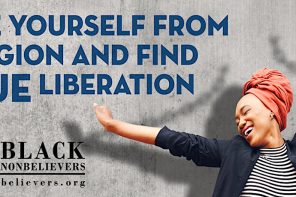Seven a.m., sitting in a bus just outside the Lincoln Tunnel. Jersey side. Far above my head shouts one of those electric billboards with ads that change every few seconds. An image of Poseidon flashes by, then Jesus, Santa Claus, and the Devil. The caption: “37 Million Americans know MYTHS when they see them.”
It’s Christmastime in the City. American Atheists has been sponsoring such billboards around the holidays for a couple of years now. And having only recently finished reading Richard Dawkins’ The God Delusion, I suddenly feel as though I might have tiptoed down the wrong garden path of a career. The writing’s on the wall for professional religionists. Or at least on the billboard. What do these signs tell us about ourselves?
Once the bus reaches the Port Authority terminal and I join the braided streams of Manhattan commuters, I hear piped-in Christmas carols. And not just “secular” ones like “Winter Wonderland.” Pushing through the doors into the chilly New York air with Johnny Mathis singing “Silver Bells” overhead, it strikes me that I have just experienced a tiny cross-section of America’s ongoing cultural crisis. We want it both ways—I realize as I pass the Wired store in Times Square—we want to reap all the benefits of secular science while keeping the comforts of a medieval spirituality.
I had returned from the American Academy of Religion and Society of Biblical Literature annual meeting—the Woodstock of religion scholars—where I had been awash in a sea of religious erudition. It helped that it was in “sunny” California. When the train conductor on the BART system at SFO announced, “The train is about ready to close the doors. Those of you on the platform might want to start thinking about getting on board and taking a seat,” it was amply clear I was no longer in New York. As I watched a literal myriad of scholars of all stripes (and spots) mingle with only the occasional sour-tempered glare, it seemed that religion might just be all right after all. Is it really the evil that Dawkins seems to indicate? Can 10,000 scholars of religion really be wrong?
This is a waffling point for the serious thinker who wants to know if there is anything to this atheism craze. I began with Dennett and moved on to Harris, Hitchens, Jillette, and Dawkins. Their God often looks to be a straw man—more properly a straw deity—easily set up, and easily knocked down. Still, they make so many valid points that anyone who thinks about religion must take pause. Serious pause. In the reflected light of that billboard outside my bus window, the scope of the dilemma unfolds.
“Where do clergy come from?” one might suppose a precocious child asking her or his parents. The clergy aren’t so different from the rest of us. Having been groomed for that profession, once upon a time, I attended seminary as a student and taught at one as an adult. For fourteen years. In between lay a doctorate in biblical studies. Along that path something became clear: the church’s dilemma. Call it a crisis of faith. It goes something like this…
Seminaries crave academic respectability. Respectability follows on from accreditation. Accreditation requires educated educators—the Association of Theological Schools of the United States and Canada, the main seminary accrediting body, likes to see PhDs on the faculty roster. Most doctoral programs require critical thinking capabilities, and critical thinking frequently calls the foundations of faith into question. A vicious cycle whirls more violently than Charybdis here. Over there is the Scylla of unprofessionalism (professors without enough letters following their names). The seminaries’ crew on this journey appears to be Dawkins and his atheistic Argonauts.
Dawkins points out in The God Delusion that many clergy are closet atheists. If they come out of the cupboard, they lose a career that they have spent many years and many thousands of dollars to attain. Isn’t it just easier to pretend? Considering that most career options to defrocked clergy (mainly unemployment) are hardly palatable, who can blame them? Statistics from Denmark and Sweden reveal what might never be politically correct among the United Saints of America—practical atheism abounds among churchgoing Christians and clergy.
At the American Academy of Religion and Society of Biblical Literature annual meeting, many seminary professors congregate. In the bookstalls, tomes on the draw of atheism shine brightly. All we need is an apple, snake, and fig leaf. These are the teachers of tomorrow’s clergy.
A hymn at my the fundamentalist church of my childhood included the lyrics, “He [Jesus at the crucifixion] could have called 10,000 angels, instead He died alone for you and me.” He could have called 10,000 angels, but instead he called 10,000 religion scholars. (And let’s not start a Twelve Days of Christmas cascading laundry list here, or this essay will never end.) The numbers tell the story. The academic study of religion has become an industry. So has the church. No matter how badly clergy want their lives to be “a calling,” they are actually jobs for which they are paid and receive medical coverage, retirement plans, and financial security (more or less). It is the way of the market.
Why are they playing “Silver Bells” when I step into the Port Authority? Does it not loosen the tightness of my purse strings and make me want to spend? To buy? To consume? Is that the Wired store over there? With the billboard still dazzling my eyes, I can nevertheless see clearly. Yes, 37 million Americans know myths when they see them. That’s because we live in one. Our myth says religion is still central to our lives, and, hey—is that the line for the Wired in-store wind tunnel over there?




